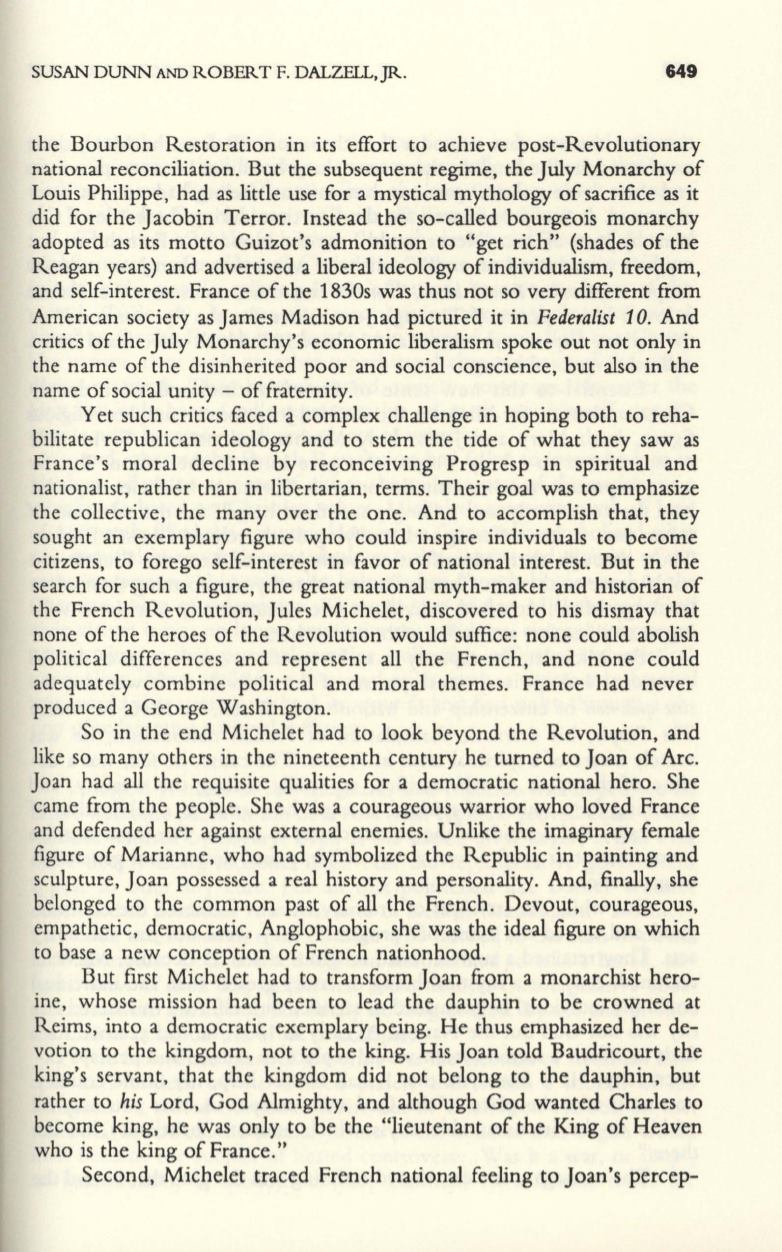
SUSAN DUNN
AND
ROBERT
F.
DALZELL.JR.
649
the Bourbon Restoration in its effort to achieve post-Revolutionary
national reconciliation. But the subsequent regime, the July Monarchy of
Louis Philippe, had as little use for a mystical mythology of sacrifice as it
did for the Jacobin Terror. Instead the so-called bourgeois monarchy
adopted as its motto Guizot's admonition to "get rich" (shades of the
Reagan years) and advertised a liberal ideology of individualism, freedom,
and self-interest. France of the 1830s was thus not so very different from
American society as James Madison had pictured it in
Federalist
to.
And
critics of the July Monarchy's economic liberalism spoke out not only in
the name of the disinherited poor and social conscience, but also in the
name of social unity - of fraternity.
Yet such critics faced a complex challenge in hoping both to reha–
bilitate republican ideology and to stem the tide of what they saw as
France's moral decline by reconceiving Progresp in spiritual and
nationalist, rather than in libertarian, terms. Their goal was to emphasize
the collective, the many over the one. And to accomplish that, they
sought an exemplary figure who could inspire individuals to become
citizens, to forego self-interest in favor of national interest. But in the
search for such a figure, the great national myth-maker and historian of
the French Revolution, Jules Michelet, discovered to his dismay that
none of the heroes of the Revolution would suffice: none could abolish
political differences and represent all the French, and none could
adequately combine political and moral themes. France had never
produced a George Washington.
So in the end Michelet had to look beyond the Revolution, and
like so many others in the nineteenth century he turned to Joan of Arc.
Joan had all the requisite qualities for a democratic national hero. She
came from the people. She was a courageous warrior who loved France
and defended her against external enemies. Unlike the imaginary female
figure of Marianne, who had symbolized the Republic in painting and
sculpture, Joan possessed a real history and personality. And, finally, she
belonged to the common past of all the French. Devout, courageous,
empathetic, democratic, Anglophobic, she was the ideal figure on which
to base a new conception of French nationhood.
But first Michelet had to transform Joan from a monarchist hero–
ine, whose mission had been to lead the dauphin to be crowned at
Reims, into a democratic exemplary being. He thus emphasized her de–
votion to the kingdom, not to the king. His Joan told Baudricourt, the
king's servant, that the kingdom did not belong to the dauphin, but
rather to
his
Lord, God Almighty, and although God wanted Charles to
become king, he was only to be the "lieutenant of the King of Heaven
who is the king of France."
Second, Michelet traced French national feeling to Joan's percep-


